
April 26, 2009
 CR Sunday Feature: The Ten All-Time Best Long-Running Comics Series
CR Sunday Feature: The Ten All-Time Best Long-Running Comics Series

 By Tom Spurgeon
By Tom Spurgeon
In
a news item that went almost unnoticed in light of
the change to quarterly publication status,
MAD Magazine is celebrating
its 500th issue. With the long-running serial comic book fading from existence, I think it's safe to say we will not see
MAD's like again.
Here are my Sunday-Morning choices for the ten best comics series of all time. A lot of this is by caffeine-fueled feel. I'm not sure that I can present a clear list of criteria employed. I find myself wanting to work with long-time series, so that meant a baseline of more than 10 years publishing. I'm staying in North America -- no
Spirou, no
Garo -- although I was tempted to fake it. I looked at artistic achievement and historical impact as equally important factors and then worked from there in terms of folding in lesser factors like influence and uniqueness. This isn't a best-works list. I think more of
Weirdo, for example, than I do six works that made this top ten. It's also not divorced from artistic considerations, so it's definitely not an industry-oriented list.
Action Comics would have to be on that kind of list, and it's not on this one. I also wanted to have the list entire cover a great deal of aesthetic and historical ground, or at least as much as that would be possible as a later consideration.
Basically, I just wanted a nice snapshot of what comics series have meant to the art form and to those who enjoyed comics that way. What follows isn't perfect and may not even be defensible, but these kinds of exercises can't be the former and sometimes work better as the latter. I hope you enjoy it. -- Tom Spurgeon
*****
 1. MAD (1952-present)
1. MAD (1952-present)
The legendary magazine and cultural touchstone brought satirical comedy of the "Everyone is Lying to You" variety to the masses, and hit a generation of media-savvy children right between the eyes. They then executed the crap out of that basic formula for decades, broadening slightly in terms of approach and sentiment but never straying far from what they do best. The initial run of Harvey Kurtzman-edited comics are as deliciously weird and inventive as their reputation, and the
Al Feldstein era with its murderer's row of great comics craftsmen is as vastly underrated as any comic ever. At the height of its influence,
MAD was
The Simpsons,
The Daily Show and
The Onion combined. Three generations of American adults not only read some excellent comics in this magazine, they saw a great deal of an age-stratified pop culture through its lenses.
*****
 2. Love and Rockets, Vol. 1 (1981-1996)
2. Love and Rockets, Vol. 1 (1981-1996)
The best long-running and organic artistic achievement in serial comic book form, the magazine-formatted
Love and Rockets spanned the lifetime of comics' growth as an art form from debates over whether anyone would read a comic that was more than 50 pages long to the first major book distribution deals. The
Hernandez Brothers inspired
and outworked a greatest generation of comics auteurs.
Jaime and
Gilbert Hernandez are each among that handful of artists who must be given serious consideration when talking about the best cartoonists working. In
Love & Rockets each created fictional worlds for the ages and used them as a vehicle for enormous artistic development, lapping the majority of their peer group. One so inclined could argue with seriousness a top 25 of American graphic novels where 1/3 of the titles listed came from this series.
*****
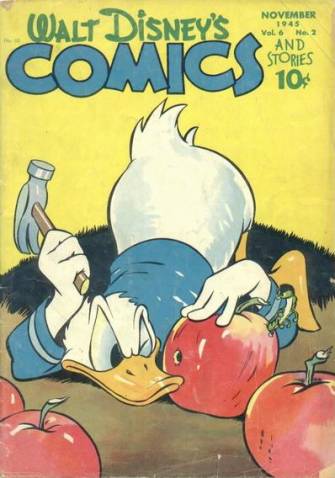 3. Walt Disney's Comics & Stories (1940-1962)
3. Walt Disney's Comics & Stories (1940-1962)
I believe this was the most popular of the Disney titles. Choosing just one of the Disney series according to artistic impact is difficult considering there were great works spread out over a few of those titles. I'm told a lot of where you stand comes down to how what weight you give which works by
Carl Barks.
Walt Disney Comics & Stories featured a significant number of contributions from Barks (originals which I believe would continue for a half-decade into the series second iteration at Gold Key) focusing on the sublime Donald Duck ten-pagers, early cover work from
Walt Kelly, reprints from
Floyd Gottfredson, and
Mickey Mouse stories by Paul Murry. The 20th Century was the comic book century
and it was the Walt Disney century, and the combination of the two gave us some of the best expressions of both.
*****
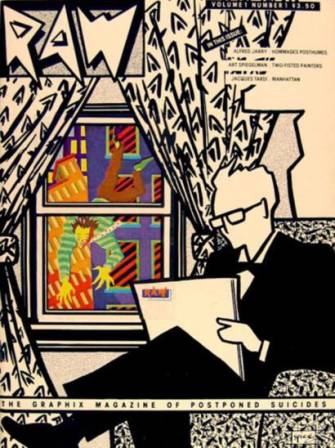 4. RAW (1980-1991)
4. RAW (1980-1991)
The standard-bearer for adult expression in comics in the 1980s,
RAW is clearly responsible for several subsequent developments within the art form. This includes but is not limited to 1) nurturing an important generation of artists that would become American alt-comix mainstays, 2) providing a first home for co-editor
Art Spiegelman's foundational
Maus, 3) bringing to American shores and putting in front of American eyes many of the best European cartoonists of two generations, 4) furiously messing with format to a liberating degree and, perhaps most importantly, 5) investing the entire enterprise with a sense of artistic legitimacy that could stand up to the most withering skepticism.
*****
 5. Zap (1968-2005)
Zap
5. Zap (1968-2005)
Zap was the best-known comic series of the underground comix, and published heavy-hitters such as
Robert Crumb,
S. Clay Wilson,
Victor Moscoso,
Spain Rodriguez,
Gilbert Shelton,
Rick Griffin and
Robert Williams. You don't really need to say anything else. All of those cartoonists are great, Crumb in particular is a giant, and no anthology has No comic series better encapsulated a quality of expression one can earmark as belonging to a specific time. It's amazing how playful the comics in
Zap could be, and how important some of the more ragged contributions and jam comics feel plopped into the middle of various quality short stories. There's going to come a point in the next 25 years where those paying attention to comics are going to have to decide how good and vital the best underground comix were as they begin to become untethered from living history and the weight they've been given as social agents backed by the self-flattery of a myopic yet statistically significant generation. My guess is we'll start that process with Crumb and
Zap, and continue with the rest of that comic's line-up and on from there into that entire period of fertile expression.
*****
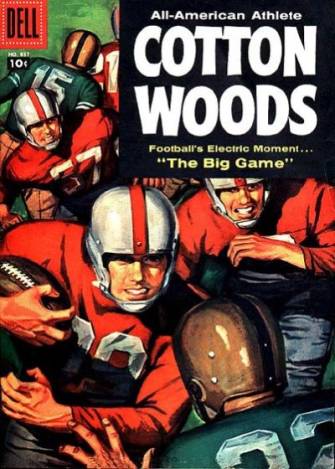 6. Four-Color Comics (1939-1962)
6. Four-Color Comics (1939-1962)
This was to my mind the most mainstream of all mainstream North American comic books, from a time when comic books were very, very mainstream.
Four-Color makes the list for the way it was set up to launch any number of titles, its success in doing so (including several Disney features) and its prodigious output. It is one hundred and eighty degrees removed from comic books as we understand and value them now: it published up to twice a week, it shifted features, it favored no particular kind of comic over another, and it went right after popular tastes like so many fast zombies loping behind a bus full of schoolchildren. It's the only comic book where looking at the covers feels like flipping through the channels on your grandmother's Philco, although its basic operation was so relatively inscrutable that
a line in a wikipedia entry suggests that a crucial task of 1960s super-fans Don and Maggie Thompson was simply figuring out who did what in
Four-Color and when, reverse-engineering a comic book TV guide. If it were around today I'm imagining a May 2009 where we might see comics on that singing woman, Somali Pirates,
The Mentalist and LeBron James. But it isn't around today. It couldn't be.
*****
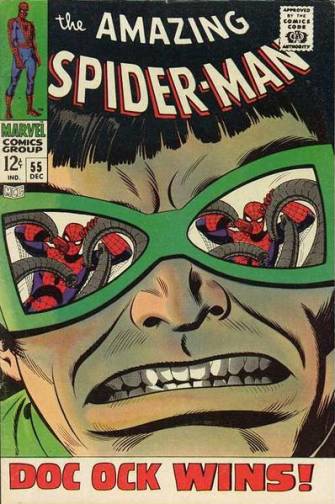 7. Amazing Spider-Man (1962-present)
7. Amazing Spider-Man (1962-present)
What would become
Marvel's enormous influence seems to my eye better encapsulated in short bursts of creativity on specific titles and the relentless quality of its line in the mid-1960s than it does any of its long-running series. That said,
Amazing Spider-Man was the Marvel comic that felt like an original Marvel comic book for the longest time. Crucially, its initial burst of creativity wasn't limited to a single run by Marvel art powerhouse
Jack Kirby but instead saw three sustained, compelling periods:
Stan Lee and
Steve Ditko's clever capsizing of the superhero genre, Stan Lee and
John Romita's romance comic-influenced take on the personal woes emphasized in the original formula that attracted so many readers to its core ideas of responsibility and emotional investment, and the first significant riffs on the Marvel formula by creators including Romita,
Gerry Conway and
Gil Kane, where
Spider-Man became a kind of issues-oriented soap opera focused on running commentary about superheroes and self-actualization in stories where, say, Gwen Stacy dies and then comes back to life in cloned form. It hasn't been as significant since, nor has it enjoyed recurring quality runs like Marvel's
Daredevil series has, but
Spider-Man's initial series of achievements is enough to earn it a place here.
*****
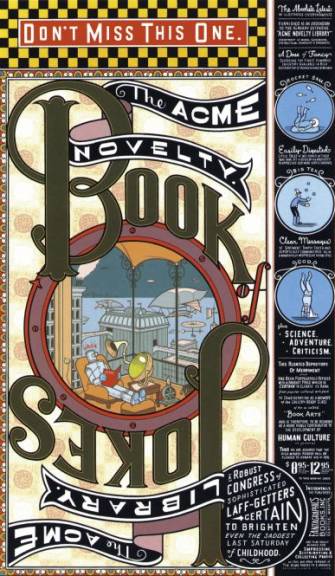 8. ACME Novelty Library (1993-present)
8. ACME Novelty Library (1993-present)
We're at a point in comics history enough time has passed that people forget what a mind-bending achievement
Chris Ware's one-man showcase series
ACME Novelty Library was when it first debuted. Even its approach to format felt radical. If
RAW played around with presentation,
ACME punched right in the scrotum the notion that every issue of a single comic book series had to look like the others. The dozens of cartoonists following his lead is the title's most obvious contribution, but hardly its greatest. Its primary value is that it presented Ware's giant talent to enough of an audience to bring him thousands of hardcore fans.
ACME also played with what people might conceive of when they thought of a serial title -- some issues of
ACME ran a continuing serial, some published gathered-together gags, and the issues that come out today look like a book more than any comic book. Perhaps the most telling thing about
ACME is that in the midst of serializing what should be another mighty collection one day, Ware can dream up a single-page that if it were the only thing he ever published people might still know his name.
*****
 9. King-Cat Comics and Stories (1989-present)
John Porcellino
9. King-Cat Comics and Stories (1989-present)
John Porcellino's mini-comic is beautiful and perfect just the way it is, and what that is is the greatest artistic achievement in the vast universe of handmade comics. It's basically one man's life story as told to an audience assembled by the whims of a crumbling, ephemeral marketplace, but it's also elegant, insightful comics.
*****
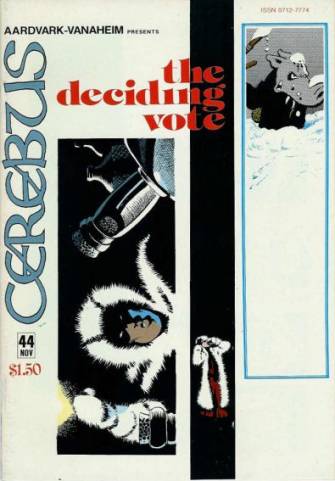 10. Cerebus (1977-2004)
10. Cerebus (1977-2004)
Although few comics readers know quite what to do with the content and themes of the book as they developed in its second half,
Dave Sim's 300-issue achievement remains monumental in terms of scope and personal ambition, and is also noteworthy for the craft chops and unique storytelling solutions frequently on display. It's probably the most fascinating
object among the great comic book series, by which I mean it's the only comic on this list I can imagine people wanting to read a collection of its letters pages or its editorials or its back-up features in addition to the several collections featuring the comics narrative.
Cerebus served quite effectively as a vehicle for Sim's personal views and as a platform for the gospel of self-publishing as a viable business choice in the Direct Market-dominant 1980s and 1990s. I don't know yet what I think of it as an artistic achievement, but I greatly enjoyed huge swaths of it. The further away from its published conclusion I get the more I'm convinced that it's
something special in terms of comics history, and the further along I get in my own artistic journey the more I'm certain that even if he doesn't realize it, Dave won.
*****
I also considered the following great series:
Weirdo,
The Fabulous Furry Freak Brothers,
Sandman,
Hate,
Eightball,
Bone,
Frontline Combat,
Optic Nerve,
Fantastic Four,
Action Comics,
Detective Comics,
Daredevil,
The Spirit,
Donald Duck Adventures,
Yummy Fur,
Classic Comics,
Monster and
Shonen Jump. No doubt I've completely spaced on a half-dozen mighty achievements of this type.
.(JavaScript must be enabled to view this email address)
*****
Michael Grabowski
I would add
American Splendor to your list. I don't think I've ever read a review that articulates precisely why Pekar's comics work, and the movie doesn't get this across either, and I sure can't explain it but there it is. He took the vision of underground comics and stripped it of its sensationalism and shock value but somehow he and his collaborators figured out how to make the absolutely mundane interesting to look at and read. Still. A lot of the artists usually work in a much less restrained fashion and it's been interesting and affecting to see what guys like Crumb, Stack, Sacco, & Haspiel can do when illustrating work that's outside their normal approach.
Pekar's publishing history has to say something positive about the book & comics publishing industry. His first Doubleday collection came out the same year at Pantheon's 1st edition of Maus, which means it was probably prepared completely independently rather than as a response to any trend. That he's enjoyed apparently good publishing relationships with a number of publishers in a few different formats suggests some kind of marketability that he has achieved for his work. The intersection between wider pop culture and Pekar's work (David Letterman and Paul Giamatti at one end, the odd play or opera at the other) has been interesting to see take place as at it all seems to have taken place on Pekar's terms (and produced its own entertaining sub-genre in Pekar's comics). Hopefully this is all another piece in the growth of comics as an accepted, expected mode of artistic expression for all manner of themes and styles.
*****
Ethan Heitner
My vote for inclusion on that list would be
World War 3 Illustrated. While having only 40-odd issues out (39) makes it seem less impressive than the runs of hundreds your list includes, I would argue that
WW3 very simply provides a home for comics that could not find a home anywhere else in the North American comics scene. I am continually curious why WW3 doesn't get more attention from the comics blogosphere.
*****
Mark Coale
I don't know if the runs are long enough, but how about: Morrison's
Doom Patrol,
American Flagg vols 1 and 2, Waid's
Flash run, Rucka's
Queen and Country, Wolfman/Colan
Tomb of Dracula, Moore/Veitch
Swamp Thing. Would you lump all the
Grendels together as one big project?
*****
Buzz Dixon
It's hard/bordering impossible to argue against any of your choices, so I'll say I wish the list had gone up to twelve and that
Archie (and attendent titles) and
Classics Illustrated had been included.
Archie has varied in focus and quality over the years, the 1950s/early 60s stories bordering on the subversive on occasion, but at its heart it was what we wished our teen years were like or, for those pre-teen readers, what we hoped it would become. I think it's fair to say Archie & friends gave millions of kids a template for their future, and while acknowledging the importance of
MAD and
Zap,
Archie provided a counter-balancing normalacy for many.
Classics Illustrated probably did a better job teaching the classics than the American public school system and on occasion they actually had some pretty decent art (I remember
The War Of The Worlds and
The Time Machine with great fondness). They certainly had more readers than the originals or Cliff Notes. They certainly made a lot of otherwise impenetrable plots clear.
*****
John Vest
When you're looking at the greatest long running series I guess the field does narrow quickly. As honorable mentions I'd include
Captain Marvel and
Plastic Man from the golden age plus Lee-Ditko
Doctor Strange and
Tales Of Asgard from the sixties.
I'd go with
Fantastic Four over
Amazing Spider-Man in the top ten. The characters' lives evolved through both series but much more dramatically in the 8 1/2 year breadth of the Lee-Kirby
FF. The Fantastic Four aged perceptibly and there was a more sober tone in later issues with increased family responsibilities. As the group appeared more often in casual attire during the final issues it's almost as if they had transcended the superhero scenario and had been taken as far as they could go.
*****
Danny Fingeroth
I second what Michael Grabowski said about
American Splendor. Harvey created his own sub-genre of compelling personal comics, which is even more impressive when you see how many people try something similar and don't succeed. Harvey makes it look easy -- which it ain't.
*****
*****
posted 8:00 am PST |
Permalink
Daily Blog Archives
November 2019
October 2019
September 2019
August 2019
July 2019
Full Archives


